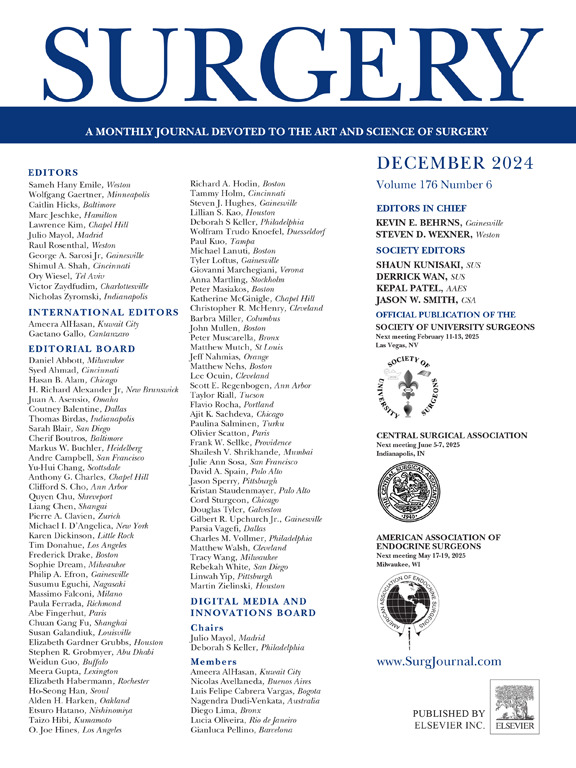最小的遭受中风:在创伤质量改善计划数据库中了解钝性脑血管损伤儿童的中风和治疗模式
IF 3.2
2区 医学
Q1 SURGERY
引用次数: 0
摘要
背景钝性脑血管损伤儿童的卒中率和治疗模式尚未得到很好的描述。在如何治疗钝性脑血管损伤儿童、抗血栓治疗相关的卒中率以及开始治疗的最佳时间等方面存在知识空白。方法对 2016 年至 2022 年创伤质量改进计划数据库中的钝性损伤(<18 岁)儿童钝性脑血管损伤进行了回顾性审查。对所有钝性脑血管损伤患儿、无外伤性脑损伤患儿亚组以及无抗血栓治疗禁忌症(无外伤性脑损伤、实体器官损伤或24小时内输血)的患儿进行了分析。比较了不同年龄组(0-6 岁、7-11 岁、12-14 岁、15-17 岁)和不同损伤等级的中风率和治疗模式。 结果在 685,631 名受钝器伤的儿童中,有 2,336 人发生了钝器性脑血管损伤(0.34%)。年龄最小的患者中风率最高(0-6 岁为 6.2%;7-11 岁为 2.0%),他们接受抗血栓治疗的比例最低。52%的患者在住院期间没有接受抗血栓治疗。与未接受抗血栓治疗的儿童相比,接受抗血栓治疗的儿童发生中风的比例更高(6.1% vs 2.1%,P < .001),与年龄组无关。低分子量肝素是最常见的抗血栓治疗药物(28.2%),其次是肝素(14.2%)和阿司匹林(5.1%)。超过一半的儿童没有接受抗血栓治疗。与未接受治疗的患者相比,接受抗血栓治疗的患者中风率更高,这可能反映了在中风发生后才进行抗血栓治疗。需要为钝性脑血管损伤儿童制定治疗指南。本文章由计算机程序翻译,如有差异,请以英文原文为准。

The smallest suffer stroke: Understanding stroke and treatment patterns in children with blunt cerebrovascular injury within the Trauma Quality Improvement Program database
Background
Stroke rate and treatment patterns for children with blunt cerebrovascular injury are not well-described. There exists a gap in knowledge of how children with blunt cerebrovascular injury are treated, the stroke rate associated with antithrombotic therapy, and the optimal time to start treatment.
Methods
A retrospective review of the Trauma Quality Improvement Program database was conducted from 2016 to 2022 for children with blunt injury (<18 years) with blunt cerebrovascular injury. Analysis of all children with blunt cerebrovascular injury and subgroups of children without traumatic brain injury, as well as those without contraindications to antithrombotic therapy (no traumatic brain injury, solid-organ injury, or blood transfusion within 24 hours) was performed. Stroke rate and treatment patterns were compared between age groups (0–6, 7–11, 12–14, 15–17 years) and injury grades.
Results
Among 685,631 blunt injured children, 2,336 incurred blunt cerebrovascular injury (0.34%). Stroke rate was greatest in the youngest patients (6.2% 0–6 years; 2.0% 7–11 years) who had the lowest rates of antithrombotic therapy. Fifty-two percent of patients received no antithrombotic therapy during their hospitalization. Children who received antithrombotic therapy had greater rates of stroke compared with those untreated (6.1% vs 2.1%, P < .001) regardless of age group. Low-molecular weight heparin was the most common antithrombotic therapy (28.2%) followed by heparin (14.2%), and aspirin (5.1%).
Conclusion
Children aged 0–11 years had the greatest rates of stroke and were least likely to receive antithrombotic therapy. More than one half of children did not receive antithrombotic therapy. Patients who received antithrombotic therapy had greater stroke rates than untreated patients, which may reflect antithrombotic therapy given after stroke occurred. Treatment guidelines are needed for children with blunt cerebrovascular injury.
求助全文
通过发布文献求助,成功后即可免费获取论文全文。
去求助
来源期刊

Surgery
医学-外科
CiteScore
5.40
自引率
5.30%
发文量
687
审稿时长
64 days
期刊介绍:
For 66 years, Surgery has published practical, authoritative information about procedures, clinical advances, and major trends shaping general surgery. Each issue features original scientific contributions and clinical reports. Peer-reviewed articles cover topics in oncology, trauma, gastrointestinal, vascular, and transplantation surgery. The journal also publishes papers from the meetings of its sponsoring societies, the Society of University Surgeons, the Central Surgical Association, and the American Association of Endocrine Surgeons.
 求助内容:
求助内容: 应助结果提醒方式:
应助结果提醒方式:


